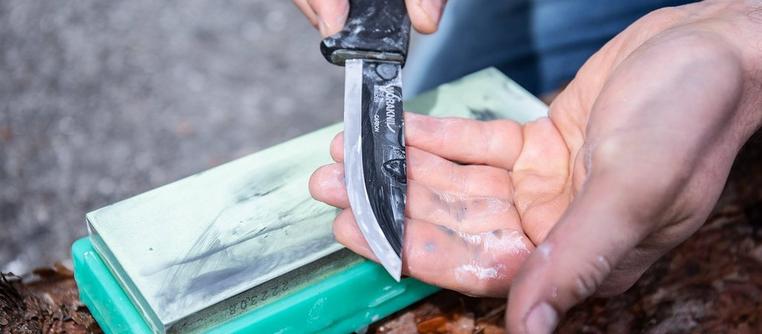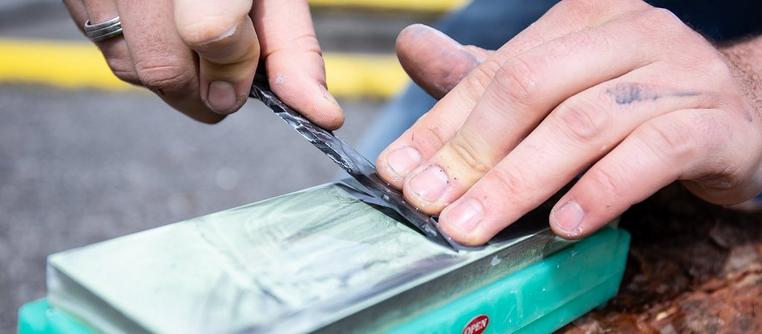How do you sharpen a scandi grind?
Many outdoor knives have been enhanced with a scandi edge. Perfect for wood work and easy to sharpen yourself. However, the sharpening aspect of this grind sometimes leads to questions. For this reason we gladly like to tell you how to sharpen a scandi grind.
What is a scandi grind?
A scandi grind is basically one of the easiest way of turning a piece of steel into a knife. A flat piece of 2-3 mm thick steel only has one slight curve towards the edge. That’s it. Not another secondary edge as you often find in kitchen knives, for instance.
Because of this simple geometry you end up with a wide edge that needs to be sharpened. Because the edge is so broad you can clearly see and feel what you are doing while you are sharpening your knife. As a result many people feel that the scandi grind is easy to sharpen.
What do you need to sharpen a scandi grind?
A scandi grind can easily be sharpened on sharpening stones because of the broad cutting edge. Whether you use diamond, natural or ceramic stones isn’t that relevant for the method: the principle is the same. Also, you could use a smaller pocket sharpening stone when you are on the road or out in the field.
Guided sharpening systems are often not that suited. After all, these systems could have trouble following the straight part of the edge, or have trouble ending up at the exact cutting edge of the knife. Pull-through sharpeners also rarely offer you enough cutting surface for these broad cutting edges, if they could exactly match the angle.
What grain sizes do you need to sharpen a scandi-grind?
You basically need the same as you would use when you sharpen a regular knife. On the basis of the Japanese standard for grain sizes you need a coarser stone for a damaged edge or if you want to re-profile the edge. Think of a 160-800 grain. Afterwards you need a finer stone to pre-sharpen the edge. For it you use a stone that has a grain in between 800 and 1500. To end up with a razor-sharp knife you use a 2000 or 3000 stone. And if you really want to polish the edge you use a 5000 stone afterwards. After that you can go crazy with 8000-10.000 stones or even 16.000 stones.
How do you sharpen a scandi grind on sharpening stones?
The scandi grind is actually perfect if you want to learn how to sharpen your knives on sharpening stones. Because of the broad cutting edge you will quickly see and feel where you are going wrong. Most scandi grind knives have a broad straight part at the edge. You place this part on top of the stone. By varying the angle you will quickly feel where the edge begins and where the ‘shoulder’ of the edge begins. The shoulder is the transition from the curved cutting edge to the flat part of the edge. So, when you move the spine of the blade up and down while the edge is resting on the stone you will feel when the entire flat surface of the cutting edge is resting on the stone.
If you feel that you know that the angle is right. Now you carefully move the knife back and forth over the entire length of the stone. Do pay attention to see if the angle is still the same. Also move the knife a little diagonally to end up with a varied scratching pattern.
It could be helpful to place your thumb on the spine of the blade once you feel that it is properly laying down on the stone. As a result the base of your thumb can rest on the stone enabling you to use the point where the spine of the blade is resting against your thumb as a reference while you are sharpening.
Sharpening the belly
Sharpening the flat part of the blade will start to feel familiar after a couple of minutes. After that it is time to sharpen the rounder part of the edge: the belly. It is something a lot of people dread. After all, maintaining the right angle will be a little more difficult.
But absolutely not impossible! A mistake often made by a lot of people is that they turn the knife up to a 45 degree angle relative to the stone to tackle that round part. That is not always the easiest method. We recommend you simply lift the handle.
By simply lifting the handle and keeping the surface level of the stone you will roll towards that part of the cutting edge on your own. Continue the same process and occasionally double-check to see if you are sharpening alongside the entire cutting edge. Even people who have been sharpening a scandi-grind as previously mentioned are surprised by this insight.










